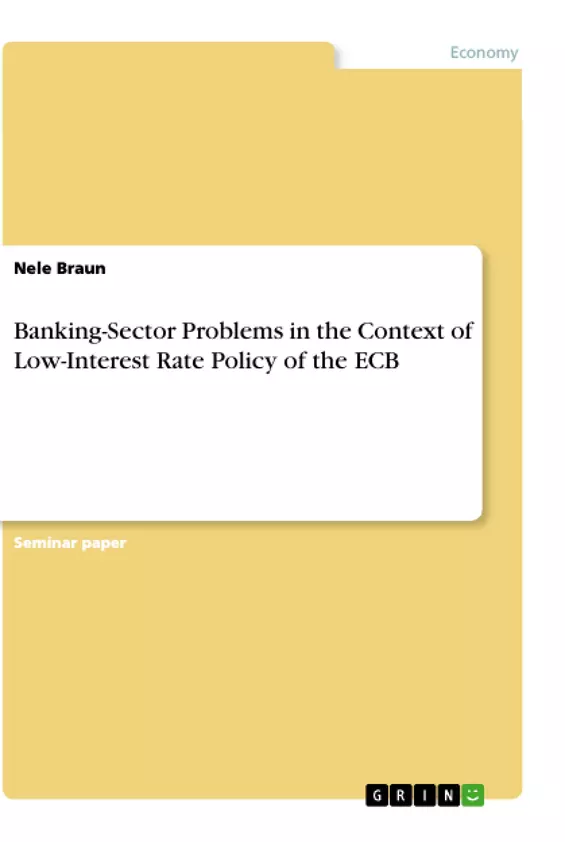This paper deals with the problems of banks in the low rate interest environment due to the monetary policy of the European Central Bank, with focus on bank earnings. Furthermore it includes a brief investigation of the interaction between low interest rates and increased regulation. Firstly, the impacts of the low interest rate policy on the banks are discussed. The next section describes the interaction between low interest rates and increasing regulation. A brief analysis examines whether monetary policy increases or decreases systemic risk follows. Finally, the main findings of the paper are discussed.
After the financial crisis in 2008, six years later the negative interest rate policy by the ECB was introduced in order to prevent the effects of the recession and to propel economic recovery. Among other effects, the ECB's low interest rates force commercial banks to lower their interest rates on loans, consequently the demand of the customers for credits rises. On the other hand, the investment of saved money bears less interest - the banks do not want to deposit the money of their customers with themselves, in some cases even penalty interests are raised. The aim of the ECB's monetary policy is therefore: more corporate investment through cheap loans and more customer consumption due to unattractive interest rates.
Inhaltsverzeichnis (Table of Contents)
- Introduction
- Low interest rates, bank balance sheets and bank earnings
- Low interest rates and the role of the ECB
- Bank Earnings with a focus on risk-taking
- Bank Balance Sheets and the effects on German banks
- Open issues
- The interaction between low interest rates and increased regulation
- Regulatory requirements – a stocktaking
- The interaction of regulation and interest rates - or even the double burden
- Does the ECB overall increase or decrease systemic risk?
- Conclusion
Zielsetzung und Themenschwerpunkte (Objectives and Key Themes)
This paper examines the problems facing the banking sector as a result of the ECB's low interest rate policy. The primary focus is on the impact of this policy on banking stability and bank behavior, particularly with regard to risk-taking. The paper also investigates how different banks are affected by low interest rates. Here are some of the key themes explored in this paper:- The impact of low interest rates on bank earnings and profitability
- The role of the ECB in influencing interest rates and its objectives for monetary policy
- The relationship between low interest rates and increased regulation in the banking sector
- The potential impact of low interest rates on systemic risk
- The varying levels of exposure to low interest rates among different banks
Zusammenfassung der Kapitel (Chapter Summaries)
- Introduction: This chapter introduces the topic of the paper, highlighting the challenges faced by commercial banks in a low-interest rate environment. It outlines the paper's structure and the main areas that will be covered.
- Low interest rates, bank balance sheets and bank earnings: This chapter explores the impact of low interest rates on bank earnings, profitability, and balance sheets. It discusses the role of the ECB in setting interest rates and the implications of low rates for bank lending and investment practices.
- The interaction between low interest rates and increased regulation: This chapter examines the interplay between low interest rates and regulatory requirements in the banking sector. It explores the potential for a "double burden" on banks, where low interest rates and stringent regulations create further challenges for profitability.
Schlüsselwörter (Keywords)
The main keywords and topics explored in this paper include: low interest rates, ECB monetary policy, bank earnings, profitability, risk-taking, banking stability, regulation, systemic risk, German banks, and the interaction of monetary policy and regulation.- Quote paper
- Nele Braun (Author), 2019, Banking-Sector Problems in the Context of Low-Interest Rate Policy of the ECB, Munich, GRIN Verlag, https://www.grin.com/document/505768



